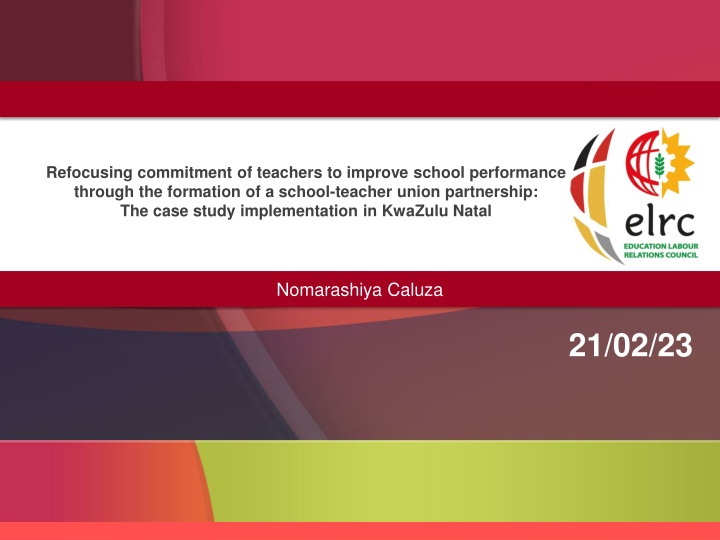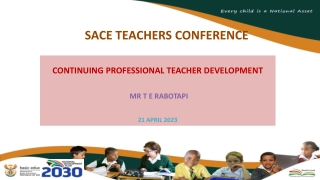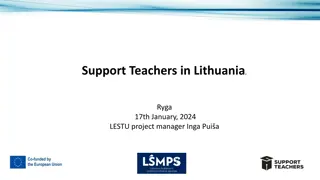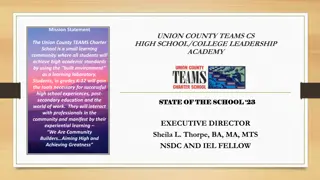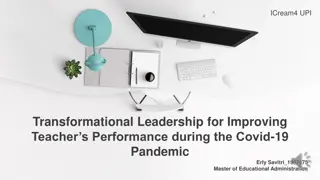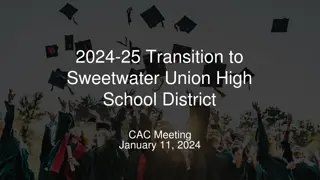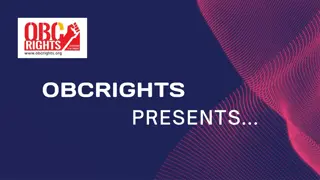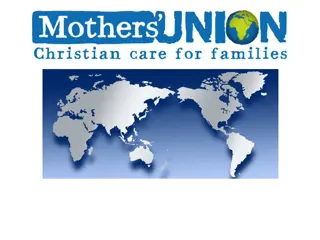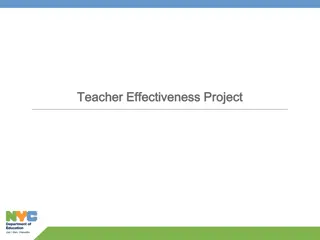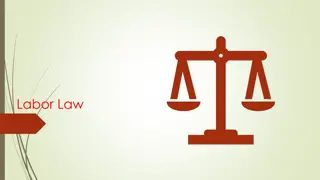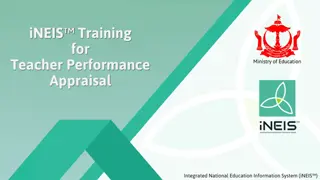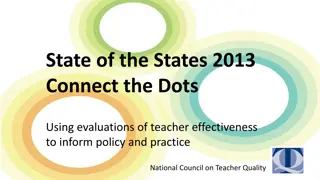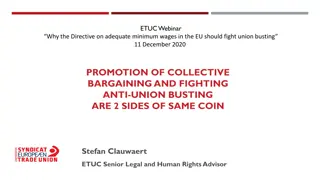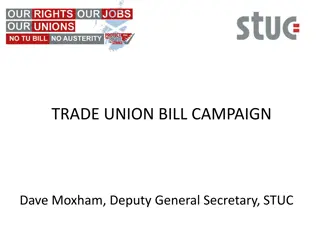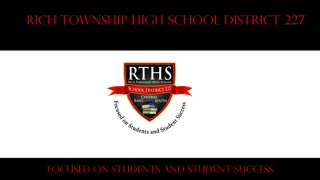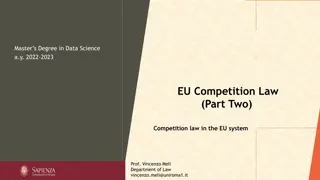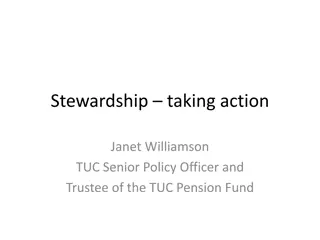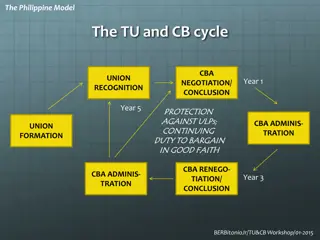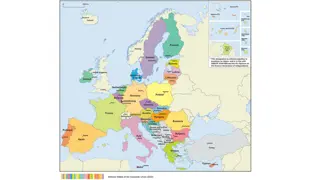Improving School Performance Through Teacher Union Partnerships
Education, Teacher Unions, School Partnerships, South Africa
Download Presentation

Please find below an Image/Link to download the presentation.
The content on the website is provided AS IS for your information and personal use only. It may not be sold, licensed, or shared on other websites without obtaining consent from the author.If you encounter any issues during the download, it is possible that the publisher has removed the file from their server.
You are allowed to download the files provided on this website for personal or commercial use, subject to the condition that they are used lawfully. All files are the property of their respective owners.
The content on the website is provided AS IS for your information and personal use only. It may not be sold, licensed, or shared on other websites without obtaining consent from the author.
E N D
Presentation Transcript
Refocusing commitment of teachers to improve school performance through the formation of a school-teacher union partnership: The case study implementation in KwaZulu Natal Nomarashiya Caluza 21/02/23
Discourses about teacher unions NEGATIVE DISCOURSE POSITIVE DISCOURSE Important stakeholder, transformation of schools and enhancement of learner outcomes can improve outcomes etc McAlister & Catone, 2013; Cele, 2013). Self serving, disruptive and obstructive and therefore unwarranted in schools. Teacher union partnerships and collaborations with schools can improve performance of schools (Mafisa, 2017; Msila, 2014). 2
Call for teacher unions to play a role Expectation that teacher unions, must contribute in uplifting the state of education in schools To improve education outcomes , teacher unions must partner with other stakeholders including school principals (NDP, 2012; Bascia, 2012; Msila, 2014; Mafisa, 2017) 3
Prevalence of partnerships in SA Schools Business Universities NGO s Though teacher unions exist exhibiting lot of trust from members, but Not much is known about partnerships of teacher unions with schools Mr Sopeni who reported that: They [teachers]tend to believe that SADTU can play the role that the employer should be playing they tend to have more faith, more trust in SADTU than the government believing that the government is not responding when they ask things, and SADTU is there for them. in almost all schools, 4
Gap Many scholars who investigated the role of partnerships in improving South African education outcomes omitted the role of teacher unions in forming and implementing partnerships with schools. Success or failure of the school-teacher union partnerships (where they exist) to produce the desired outcomes. Hence the study: From a sinking school to a moving school : A case study of a school-teacher union partnership to facilitate school improvement 5
Sinking school Teachers are resistant to change school climate exhibits tensions and non-cooperation between stakeholders Learners are non-committal to school programme Moving school characterised an environment that fosters teacher commitment participatory goal setting, which enhances learner engagement (Stoll & Fink, 1996). 6
Aim of the partnership To facilitate school improvement In terms of learner outcomes o The case study school: 0% in 2017 7
Study Methodology Qualitative study Case study Purposive sampling Participants Drawn from: 1. 2 - SADTU (National & Prov Leader) 2. 5 - SADTU School Improvement Initiative Team (SSIIT) 3. 3 - PED (Circuit, District & Prov) 4. 1- SGB 5. 5 - School teachers incl Princ. DATA COLLECTION 2 focus group discussions 6 semi-structured interviews Transformational 8
Partnership initiated school improvement programme Characterised by a clear school improvement programmes that are understood; Collectively implemented by teachers, learners, SGB, parents, and stakeholders, and one that is planned, coordinated, and led by the school management and teacher union. 9
Findings The school-teacher union partnership: Mobilise resources for the school Has a positive impact on school performance, teacher development and learner achievement Restores relations and allows teachers to focus on the core business of the school Change the culture of the school It applies evidence-based approach which empowered management, teachers and learners through shared accountability for action and results 10
Planning the course of action Localised to directly respond to challenges faced by the school: This means the programme itself was determined by the material conditions that were prevailing at Kuzolunga Secondary School. To substantiate this view, Mr Tshintsho had this to say: What we were doing was to meet with the SMT and teachers to get their side of the story as to why the school is doing badly or has challenges, allow them to voice their frustrations and challenges so that we develop programmes together based on what the school indicate as their challenges. 11
Views of role players - Teacher In the partnership with SADTU, we were given a lot of training by a team of the Lead Teachers who were, from schools in the province. Schools performing very well. They shared with us some very diverse strategies of how to manage schools, how to achieve good results, how to to manage relations between discipline learners and how to form good relationships in the schools, community and all stakeholders. educators, how to 12
Also: The study found that refocusing the commitment of teachers is key to improving school performance. This was further confirmed by Mr Progress who says: But also, they realised that they needed to support each other, create a buffer around each member of the very small staff so that all the members in the school would feel safe and feel protected and all of them would sing from the same hymnbook. Incapacity of principals and parents hinders success of the partnership. located the centrality of the principal in the formation of the school-teacher union partnership and its success in improving the school 13
Organisation of a school-teacher union partnership Development of structures, (SSIIT) Allocation of tasks: (specific roles with clear timeframes ) FACILITATING IMPLEMENTATION AND ACCOUNTABILITY Allocation of resources: part of this should be to augment the meagre resources the schools had. Mr Sopeni said: The Union was able to deploy the financial resources and human capital and then parents expressed a view of appreciation, a view of empowerment, a view that says this Union understands our plight. 14
Provision of resources: Principal SADTU recommended to the Head of Department (HOD) that we be assisted with two additional posts above Post Provision Norm (PPN) so that we could ease the burden from other teachers and indeed we were given those posts and that assisted a lot. He added that: Based on the shortage of books the Union provided each learner a study material. There was no sharing. Provided by the Union at no cost. It was a well- balanced set of study guide so that it why our learners improved. 15
Getting the buy-in of other stakeholders Learners were engaged The principal shared how they engaged learners to support the partnership intervention. We prepared them psychologically that they must welcome teachers that were coming and not to be afraid to ask questions when they come, and they interacted very well with them. Parents were put on speed regarding the partnership and its progress in the school. Mr Khoza alluded as follows: They (parents) supported it fully and we had to report time and again about our engagements with the Union. The above assertion is confirmed by the SGB member as she said: Usually, as parents we were invited to meetings where we were informed about the children s performance. 16
Getting the buy-in of other stakeholders (cont.) Mr Sopeni, talking about how SADTU manages to make their members commit to their classroom duties, said: To improve the quality of education as a tool to emancipate. We always go back to our preamble, go back to our code of conduct. So, this is also covered in what we call our 2030 Vision. 17
Views of the PED Dramatic improvement of results The department acknowledged that before this partnership they were judgmental in their approach towards teachers in poor performing schools, which eventually led to resistance amongst educators Teacher unions are an important stakeholder in achieving the goals of the Partnership 18
Views of the PED (cont.) Approach and attitudes play a role in the acceptance and success or failure of the school improvement initiatives Admitted that SADTU s holistic and multi-stakeholder approach was useful in dealing with complex school and learner performance issues and teacher behavioural challenges 19
Key learning The school-teacher union partnership created a platform for role players to reflect on their approaches/ attitudes/practices leading to them realising the need to review and adapt their approaches to tackle challenges undermining performance in underperforming rural schools. One participant from PED: As officials of the Department, we must learn to work together with the union members, teachers or leaders within our schools ... because most of the time we would have plans that cross different directions to each other and that makes us not succeed. 20
Views of the Kuzolunga school Empowered as management, educators, learners and the community The establishment of effective culture of teaching and learning Improved their confidence and felt motivated to continue with their work in the school Was that teachers relied on each other for learning and sharing of expertise 21
Views of the Kuzolunga school (cont.) The partnership created opportunities for synergies and a common focus on goal achievement, intergroup learning, relationship building and mutual interdependence The key learning from this, was that teachers learn better from their peers. Teachers view was that the school- teacher union partnership developed them thereby ensuring that they approach their teaching with confidence 22
Views of Kuzolunga staff Empowered/ developed School culture change Motivated Reinforced trust/support More confidence 23
Improved relations This was further confirmed by Mr Progress who says: But also, they realised that they needed to support each other, create a buffer around each member of the very small staff so that all the members in the school would feel safe and feel protected and all of them would sing from the same hymnbook. Mr Khoza mentioned: So, after eliminating fights between educators and the SGB we managed to create an environment of quality teaching and learning In illustrating his view, Mr Khoza said the following: A recommendation was made that we should receive learner transport. So, we have managed to eliminate the issue of late coming and the issue of prevalent learner absenteeism in the school. 24
Key learnings Schools underperform because of learner and teacher disengagement which is characterised by tensions and infightings I also learnt that school leaders sometimes allow such situations to get worse instead of resolving them THUS THREATNENING LABOUR PEACE IN SCHOOL The centrality of school principals in influencing positive attitudes of teachers towards their schoolwork 25
Key learnings (cont.) As part of addressing these challenges around disengagement of teachers, school principals must be empowered to foster and build a nurturing and supportive environment that allows and encourages social and emotional learning, sustained school positive relationships that facilitate collaborative teaching and learning practices Teacher unions working with the Department must introduce developmental programmes that motivate and empower teachers to fully participate in the decisions making in their schools. This will ensure that teachers have a buy-in in the activities of the school and partnership and instil accountability 26
Improvement in School Performance Participant DEO2 described improvement in school performance as follows: Remember the school had performed at 0%... the school moved the following year to 56%. It was a dramatic increase and the following year the school moved to 100%. 27
Improvement in School Performance (cont.) Mrs Qadi complimented participant DEO2 by stating the following about Kuzolunga Secondary School's performance after the intervention: 100% pass rate. The positive attitude is that it gives confidence, with the learners even the community, they start to see you differently, they were not trusting you. this goes a long way. Mr Khoza described the transition from the old school culture (i.e., low performance) to a high- performance culture as follows: So, after eliminating fights between educators and the SGB, we managed to create an environment of good teaching and learning within the school, and when it comes to discipline, we discipline learners as the unity ... we work in unison. 28
In conclusion I view the partnership between schools and teacher unions as a platform that can redefine the future of the school and change the public s perception about teacher unions In my view, the school-teacher union partnership must be explored as one of many partnerships that can help schools to improve their performance 29
Recommendations Practice: Using collectivism in the school improvement initiatives Policy: Institutionalise partnership of unions and schools & Management course/qualification Theory: An African leadership perspective on school- teacher union partnerships (Ubuntu, collaborate than competing) 30
